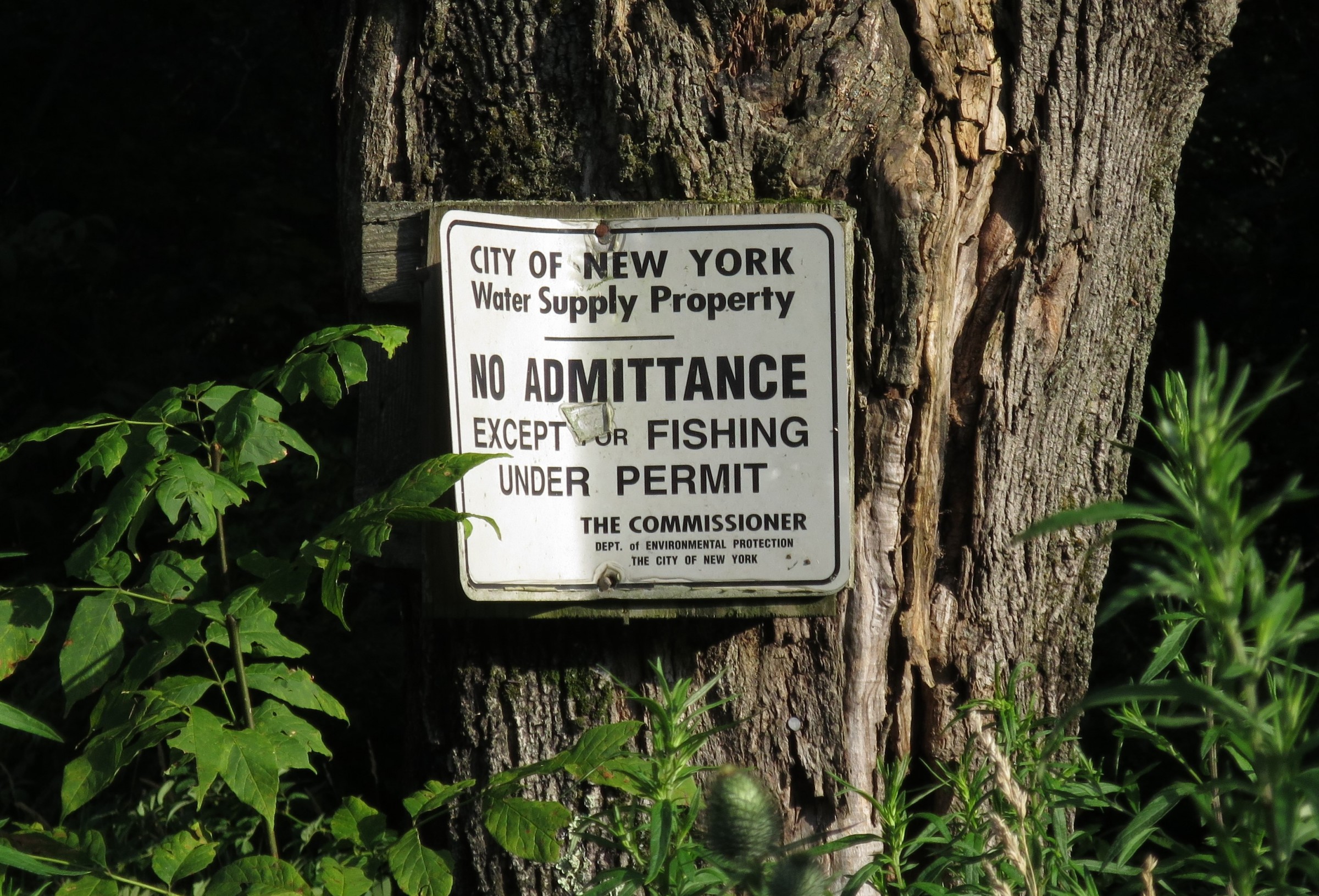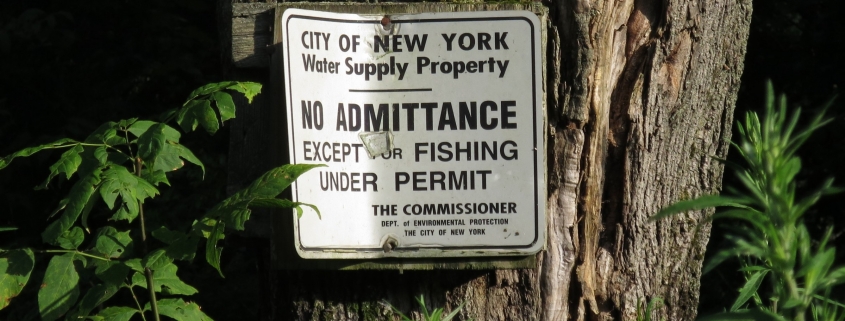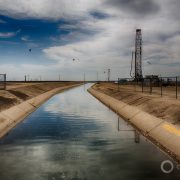After More Than Two Decades, Landmark New York City Watershed Protection Plan Is Working
Expert panel says investments to prevent pollution have been a success, but face new challenges.

A sign near Cannonsville Reservoir warns against trespassing onto lands in the Delaware watershed that supply drinking water to New York City. As part of a plan to protect its water supply, the city bought land around the reservoir to prevent development. Photo courtesy of Flickr/Creative Commons user Paul Comstock
By Brett Walton, Circle of Blue
A groundbreaking, multibillion-dollar watershed protection plan launched more than two decades ago by New York City and rural partners sufficiently protects the city’s drinking water supply from contamination, according to the findings of an expert panel.
Since 1997, New York City has spent some $2.5 billion on ecosystem protection in the Catskill and Delaware watersheds, the source of most of the city’s drinking water. The money has been put to good use: upgrading 42 wastewater treatment plants, buying out land to prevent development, and stabilizing stream channels to prevent erosion. The funds also replaced failing septic tanks, trapped pollutants in stormwater, and helped dairy farmers control nutrients and pathogens from their manure.
The investments in high-quality source water have been a relative bargain for the city. Together, these program components have forestalled the need to construct a water filtration plant, estimated to cost up to $10 billion, plus annual operating expenses of several hundred million dollars.
Added up, the program is a compelling example of successful watershed management in action, according to Jay Lund, a member of the National Academies of Sciences, Engineering, and Medicine panel that issued the report.
“It’s a remarkable success,” Lund, a professor of civil and environmental engineering at the University of California, Davis, told Circle of Blue.
Vincent Sapienza, commissioner of the New York City Department of Environmental Protection, which oversees the city’s water supply, called the 435-page report “thorough, honest, and objective.” He added that the recommendations will set the table for the next generation of the program, which must contend with a new cast of stresses due to a changing climate.
“Their comprehensive study sets an agenda for discussions in the coming years between DEP, our regulators, and our watershed partners, as we collaborate on future efforts to protect water quality and promote community vitality in the watershed,” Sapienza said in a statement.
Landmark Agreement
The New York City water system is a behemoth, supplying about 1 billion gallons a day to roughly 9.5 million people. Most of that water — 90 percent or so — comes from the Catskill and Delaware watersheds and is delivered through a network of aqueducts and tunnels that, combined, extend more than 175 miles from upstate forests to treatment plants at the metro area’s outskirts.
The city does not filter the water from the Catskill-Delaware system, a treatment step that most cities take to meet federal drinking water standards. The U.S. Environmental Protection Agency granted the city a waiver from the filtration requirement after the city signed an agreement in 1997 with upstate communities in the two watersheds.
The agreement was a landmark event for the region’s politics, economy, and water supply, a compromise that aimed to secure high-quality water for the city and economic development for the rural areas. It resulted in the watershed protection plan that the National Academies panel reviewed.
The report argues that the watershed protection program, though largely successful, needs revision, for several reasons. The water-quality benefits from early investments in land acquisition and infrastructure upgrades have already been realized.
Lund said that the Department of Environmental Protection should “rebalance” its land acquisition spending and focus on maximizing benefits of its fund. “If you’re going to make an investment, you want to get the most out of it,” he said. The department needs better tools for evaluating the benefits, he added.
Instead of more land purchases, which have already targeted the parcels of highest value to the department, the report recommends funding comparatively neglected areas that have the potential for greater water-quality improvements: septic system upgrades, timberland management, and controlling nutrients. Hundreds of septic systems, for instance, line the shores of Kensico Reservoir. The report recommends that these septic tanks should be replaced with top-of-the-line models or the area should be served by a treatment plant.
Craig Cashman, executive director of the Watershed Agricultural Council, told Circle of Blue he could not comment on the report because he was still reviewing it. The council works with landowners to implement the watershed protection program.
Local partners like the Watershed Agricultural Council and the Catskill Watershed Corporation are essential to making the agreement work. The bond is explicit: the 1997 agreement aims not only to improve water quality but also to enhance “economic vitality” of watershed communities.
Though water quality has been extensively analyzed since the agreement was signed, the economic component has been given minimal attention, the report argues.
Future Troubles
Climate change presents new challenges as well, Lund said.
Stronger storms could rip through the region, churning the waters and increasing erosion. The northeastern states have witnessed the largest increase in storm intensity and frequency nationwide, according to the National Climate Assessment. Turbid waters, because they allow less light to penetrate, interfere with the ultraviolet disinfection that is the core of the city’s water treatment process. To maintain the filtration waiver, the city is subjected to strict turbidity requirements.
The expert panel conducted a stress test against a high-turbidity scenario. The panel modeled the effect on the treatment system of a double hit: back-to-back tropical storms that generated worse river conditions than the most-severe storm on record. The system, in this test, performed well. Having multiple water sources — not only a half dozen reservoirs in the Catskills-Delaware system but also the Croton system and groundwater sources — allowed operators to meet water demand in the hypothetical event while keeping water at or just above turbidity standards. Even in harsh conditions, violations of water quality standards would be “rare and small,” the panel found.
Besides murky waters, a warming climate presents other threats. Heat, in combination with nutrients in the region’s waterways, offers the prospect of more algal blooms in the system’s reservoirs. Some of these blooms are toxic, and others produce foul smells and odors in the finished drinking water. Either way, they are to be avoided.
These future water-quality stressors — turbidity, phosphorus, algae, heat, stronger storms — are a different set of worries from two decades ago, when the primary concern was pathogens.
Those factors will come into play in the next review of the Department of Environmental Protection’s filtration waiver. The department received a 10-year extension in 2017.
Adam Bosch, a spokesperson, said that the waiver requires the department to meet with regulators and program partners to discuss the National Academies study within four months of publication. Those talks are likely to start this fall, he said.
Brett writes about agriculture, energy, infrastructure, and the politics and economics of water in the United States. He also writes the Federal Water Tap, Circle of Blue’s weekly digest of U.S. government water news. He is the winner of two Society of Environmental Journalists reporting awards, one of the top honors in American environmental journalism: first place for explanatory reporting for a series on septic system pollution in the United States(2016) and third place for beat reporting in a small market (2014). He received the Sierra Club’s Distinguished Service Award in 2018. Brett lives in Seattle, where he hikes the mountains and bakes pies. Contact Brett Walton












Leave a Reply
Want to join the discussion?Feel free to contribute!